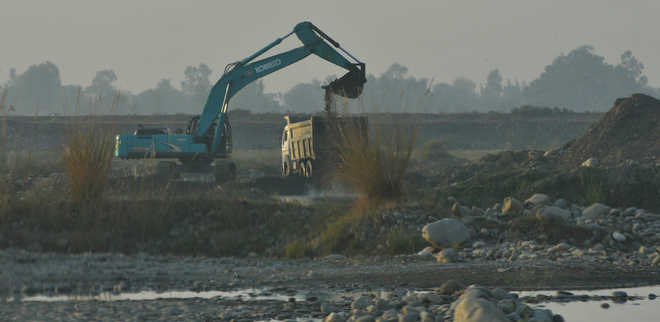Sanjeev Singh Bariana
Late in the evening, after the Chak Ramsahai mine is closed for the day, Tarsem Lal, a chemist of Sehora village, hears the roar of trucks carrying sand from illegal quarries along the Ravi riverbed.
“Officially, sand mining can’t be done after sunset, but our families have to bear the rattle of machinery and vehicles throughout the evening and the night,” he says. Only this mine is operational out of the five in Bhoa constituency, but that’s the official line. A senior officer confides on the condition of anonymity, “There are confirmed reports of illegal mining at certain places, but we don’t have adequate manpower to curb the menace.” Excuse or explanation? That’s anybody’s guess.
Jeevam Ram, a retired government official from Polla village, gives us a glimpse of the terror unleashed by the mining mafia. “Reta badmaash chakwande ne. Kise ‘don’ de ishare te kam karde ne. ‘Don’ vi kyee ne, uchchi uchchi thhan te. Raat nu daaru peeti hundi hai mulazman ne, so asin darde haan. Police aithe aundi nahin te na hi sarkaar. Je sarkaar dilon chhave taan hi kucch ho sakda hai (Sand is illegally lifted at the behest of the don’s goons. There are many influential ‘dons’. The goons get drunk at night… we are scared. Neither the police nor the government comes here. If the government sincerely wants to end this menace, it can be done).”
When asked to identify these “dons”, Tarsem Lal says evasively: “Eh saanu na puccho. Pata sarian nu hai (Everyone knows who they are).”
Moving ahead, The Tribune team takes a turn, traversing a badly damaged road at Saab Chakk. A truck without a registration number is seen ferrying sand. Azhar Mehmood, who is managing his stables, says, “Pata nahin kaun ne. Hairaani hundi hai, eh main road chhad ke tutti sadak te kitthe jaande ne (I don’t know who they are. I am surprised why they leave the main road and travel on this one).” We can’t say with certainty whether he is expressing ignorance or taking us for a ride.
Prince Pal, a Class-XII passout who works as a motor mechanic, highlights the other ills plaguing the area. “The entire district (Pathankot) has no industry, so no jobs are available. The neighbourhood is flooded with ‘chitta’(drugs). The suppliers, who are outsiders, come in their vehicles and distribute it openly. They keep changing the spot where the addicts are given their daily fix. This is happening right under the nose of the local administration and the police,” says Prince, who is doing a course at a private polytechnic in the hope of bettering his job prospects.
The bus stand at Bamial was inaugurated in February last year, but it wears a deserted look. A big settlement near the Indo-Pak border, Bamial has a market that caters to the adjoining areas. Walking through a maze of crowded shops, an elderly Nachhatar Singh wonders why a remote corner of the village was picked to establish the bus stand. “One has to cross the whole market to reach there,” he says, frustration writ large on his face.
There are several roads crying for attention, including Bamial-Janial, Janial Chakkk Amir and Dostpur-Kot Bhattian. Ajay Singh, a member of the Taloor village panchayat, says, “Pontoon bridges have come up at places such as Sakol along the border. This still does not solve the problem for a major chunk of the people who are left stranded in their villages, particularly during the monsoon. Getting heavy machinery and luggage here continues to be a big issue. We still need bridges at many other places, including Taash and Mastpur.”
According to Hazoori Lal, a social activist, the functioning of the government offices leaves a lot to be desired. The tehsildar office at Bamial opens only once a week, while the one at Narot Jaimal Singh opens only twice, much to the chagrin of the public. “Other offices are no better,” he adds.
The scenario is no better in the government hospitals. Ramesh Lal, a retired schoolteacher from Sehora, says, “The hospital in our village caters to nine villages. However, we don’t have even a single doctor on duty.” The government hospital at Bamial, which covers nearly a dozen villages, is only marginally better: It has one doctor and bare-minimum infrastructure.
With the code of conduct likely to be announced shortly, BJP MLA Seema Kumari is going all out to get the roads metalled. Surinder Pal, who runs a shop on the Sunderchakk-Bamial road, can see through these last-ditch efforts. He puts it bluntly: “A one-kilometre stretch on the left side of my shop got a concrete layer only day before yesterday. The MLA is in a tearing hurry to erase more than four years of non-performance.”
Ram Singh of Anyal village, a wizened old man, knows the political game inside out, having seen it closely over the decades. “Bana te lokan nu moorakh rahe ne par lok ajj kal shauq naal bande ne (These days, people prefer to be befooled),” he says. The way things are, his cynicism is hard to contest.
Unlock Exclusive Insights with The Tribune Premium
Take your experience further with Premium access.
Thought-provoking Opinions, Expert Analysis, In-depth Insights and other Member Only Benefits
Already a Member? Sign In Now











